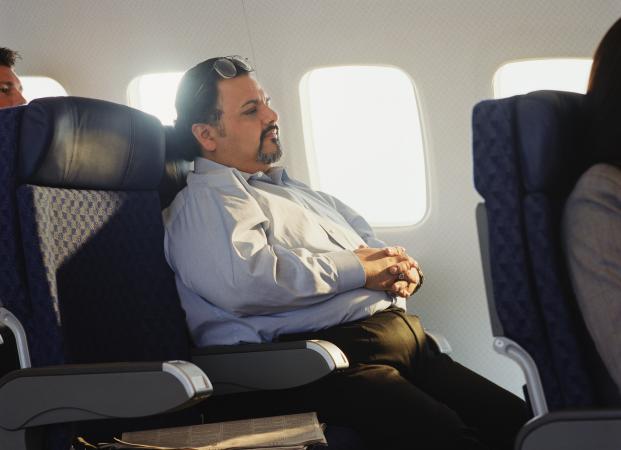picard102
Senior Member
That is not the point...if some canadians hate America so much why do they use so many of its services and products so much and enjoy its culture.
Ubiquity. This isn't hard to parse.
|
|
|
That is not the point...if some canadians hate America so much why do they use so many of its services and products so much and enjoy its culture.
The look on her face says, "This plexiglass window is nice, but how about a manspreading protector too?"

That airplane design makes my claustrophobia scream. We're already packed tight and now this? I would assume the plexiglass panels would have to swing in and out in order to get through to the window seat which can be awkward enough on some flights. So just another touch surface to gather germs.
Aviointeriors, an Italian manufacturer of airline seats, have developed two potential concepts to protect passengers from the spread of viruses.

A new airplane seat could protect passengers from viruses (PHOTOS) | Mapped
Italian manufacturing company Aviointeriors is seeking to ease the minds of travellers by developing plane seats that will help protect them from viruses.dailyhive.com


?

Toronto, Canada and Global Breaking News – CP24
Most recent News News business news stories and video from CP24www.cp24.com
Ontario Premier Doug Ford’s mother-in-law has tested positive for COVID-19 in her Toronto-area long-term care home, one of more than 2,000 residents in the province who have been sickened by the disease.
Mr. Ford became emotional on Thursday when speaking about his wife Karla Ford’s 95-year-old mother, who is a resident of West Park Long Term Care Centre in York.
He referenced the front page of the Toronto Sun newspaper, which shows a woman visiting her family with her hand pressed against the glass.
“You see a loved one with their elderly parent and they put their hand up against the window, that’s heartbreaking,” Mr. Ford said.
“I relate to it in our own family.”
Although he didn’t say it publicly, the Premier’s Office later confirmed that Mr. Ford’s mother-in-law recently tested positive for COVID-19. According to West Park’s website, 49 residents have tested positive for COVID-19, as well as 30 staff, and 13 people have died.
As of Thursday, Ontario had reported 516 deaths from COVID-19 in long-term care homes – 72 per cent of all deaths in the province.
“My heart breaks for the people and the families,” Mr. Ford said.
He also echoed Prime Minister Justin Trudeau, saying the long-term care system needs to be improved, although he didn’t specify in what way.
“The system needs to be changed, and we’re changing the system, but right now our main focus is to make sure we protect the people inside these long-term care homes,” Mr. Ford said.
Mr. Trudeau on Thursday said Ottawa will be heeding calls for military assistance to hard-hit nursing homes in Ontario and Quebec, but added that soldiers should not be caring for seniors in the long term.
Mr. Ford said he’s glad that the federal government has approved its request.
“We have literally called in the troops, and the cavalry is on its way.”
Mr. Ford’s mother, Diane Ford, died of cancer in January at age 85.
He just wants the Air Canada staff in those outfits...................I can see a union grievance over that......?
The Spanish Flu first struck in early spring (1918), just as the Ludendorff Offensive was getting underway. It rested during the summer but in the fall attacked again with dreadful effect. By the end, the Flu would kill five times as many people as all of the guns, bombs, and torpedoes of all the combatants in World War I.
By spring 1918, Germany had won the war in the East and believed that it potentially had a decisive advantage in the West. Consequently, the Germans prepared a massive offensive named after its primary architect, Erich Ludendorff, designed to break Allied lines and bring about an end to the war. Launched on March 21, the offensive tore huge holes in Allied lines and threw the Allies back at a rate unseen since 1914. Eventually, however, the offensive flagged as the Germans ran low on troops, and as the Allies poured personnel, tanks, aircraft, and heavy artillery into the front. By mid-July, the initiative had passed to the Allies. The flu undoubtedly sapped the strength of the Ludendorff Offensive; Ludendorff himself reported that daily illness reports left him worried for the survival of the army. However, because of its relatively mild impact in the first wave, and also because the French, British, and U.S, armies were also seriously afflicted by the disease, it’s likely wrong to suggest that the Flu defeated the German offensive.
The second wave was different. As the Allies launched what became known as the Hundred Days Offensive, the virulent recurrence of the influenza struck the Germans hard, in large part because of a drop in morale in the wake of the failure of the Ludendorff Offensive, but also because of the increasingly dire supply situation that left German soldiers hungry and vulnerable. Fourteen thousand German soldiers reportedly died of the flu, although wartime censorship may mean that the figure is much higher. Worse for the Germans, the flu left much of the army incapable of fighting during the desperate days of autumn 1918. Soldiers from Austria-Hungary suffered at similar rates.
The Communicable Disease Center was founded July 1, 1946, as the successor to the World War II Malaria Control in War Areas program of the Office of National Defense Malaria Control Activities.




